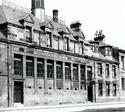 Between 1830 and 1914 appalling social conditions in Glasgow reeked havoc upon the health of its citizens. Overcrowded and damp tenement houses encouraged tuberculosis and rheumatic diseases. Respiratory illnesses increased as heavy industries created unprecedented levels of environmental pollution. However, the fever epidemics that frequently rampaged through the city until the 1870s were the most feared of all diseases. The first cholera epidemic in 1832 proved particularly alarming to the middle-classes. Measles, scarlet fever and diphtheria were also killer diseases in malnourished and rickety children.
Between 1830 and 1914 appalling social conditions in Glasgow reeked havoc upon the health of its citizens. Overcrowded and damp tenement houses encouraged tuberculosis and rheumatic diseases. Respiratory illnesses increased as heavy industries created unprecedented levels of environmental pollution. However, the fever epidemics that frequently rampaged through the city until the 1870s were the most feared of all diseases. The first cholera epidemic in 1832 proved particularly alarming to the middle-classes. Measles, scarlet fever and diphtheria were also killer diseases in malnourished and rickety children.
 Despite this dismal picture of 19th century Glasgow, reformers eventually made some progress. The Poor Law of 1845 made rudimentary provision for the destitute sick. In 1859, the health of Glaswegians benefited from a pure water supply from Loch Katrine. But far more important were the dynamic efforts of medical officers of health, Dr J B Russell (1872-1898) and W K Chalmers (1898-1925) who uncompromisingly increased public and civic awareness of the shortcomings in public health and social conditions. Philanthropic activity in Glasgow also rose dramatically from the mid-19th century onwards. Medical charities, such as dispensaries, and convalescent and fresh-air fortnight homes, were a popular focus for philanthropists.
Despite this dismal picture of 19th century Glasgow, reformers eventually made some progress. The Poor Law of 1845 made rudimentary provision for the destitute sick. In 1859, the health of Glaswegians benefited from a pure water supply from Loch Katrine. But far more important were the dynamic efforts of medical officers of health, Dr J B Russell (1872-1898) and W K Chalmers (1898-1925) who uncompromisingly increased public and civic awareness of the shortcomings in public health and social conditions. Philanthropic activity in Glasgow also rose dramatically from the mid-19th century onwards. Medical charities, such as dispensaries, and convalescent and fresh-air fortnight homes, were a popular focus for philanthropists.
 Many new hospitals were established in Glasgow, some by voluntary contributions (e.g. Western Infirmary, 1874) others by Poor Law Authorities (e.g. Stobhill, 1904) or Glasgow Corporation (e.g. Kennedy Street Fever Hospital, 1865). By 1911 a reduction in mortality figures provides evidence of some overall improvements in health from 1830. Nevertheless, reform still fell short of that necessary to ensure good health for all Glaswegians.
Many new hospitals were established in Glasgow, some by voluntary contributions (e.g. Western Infirmary, 1874) others by Poor Law Authorities (e.g. Stobhill, 1904) or Glasgow Corporation (e.g. Kennedy Street Fever Hospital, 1865). By 1911 a reduction in mortality figures provides evidence of some overall improvements in health from 1830. Nevertheless, reform still fell short of that necessary to ensure good health for all Glaswegians.